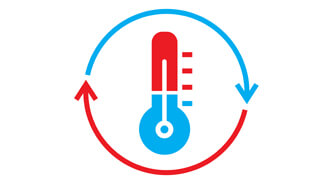<< View SCS Blog
A Guide to Parylene Service Temperatures
A specialized chemical vapor deposition (CVD) process adheres Parylene conformal coatings to substrates. CVD uniformly encapsulates all exposed substrate surfaces as a gaseous monomer; completely eliminating wet coatings’ liquid phase and need for post-deposition curing. Synthesizing in-process, CVD polymerization requires careful monitoring of temperature levels throughout.

Beneficial thermal properties of Parylene protective coatings include reliable performance through an exceptional range of temperatures. Parylene is available in variety of material formats, prominently types C, N, D and Parylene HT®. Each has a particular range of properties that determine its optimal uses. Types C and N exhibit faster deposition rates than other Parylenes, making them useful for a wider range of coating functions. However, operating temperature is a significant determinant of use. Much depends on chemical composition.
- Used more frequently than other Parylene types, Parylene C is a poly-monochoro para-xylene. It is a carbon-hydrogen combination material, with one chlorine group per repeat-unit on its main-chain phenyl ring. In oxygen-dominated atmospheres, C conformal films regularly provide reliable assembly security at temperatures of 80°C for 100,000 hours (approximately 10 years). C is suggested for use in operating environments reflecting these temperature conditions. Chemical, corrosive gas, moisture and vapor permeability remain consistently low. C generates exceptional vacuum stability, registering only 0.12% total weight-loss (TWL) at 49.4°C/10-6 torr (1 torr = 1/760 SAP (standard atmospheric pressure, 1 mm Hg). C can also be effective at temperatures well below zero degrees Celsius.
- With a completely linear chemical format, Parylene N is the most naturally occurring of the Parylene series. Used less regularly than type C, N is highly crystalline; each molecule consists of a carbon-hydrogen combination. N’s melting point of 420°C is greater than most other XY types. Vacuum stability is high, registering TWL-levels of 0.30% at 49.4°C, and 10-6 torr. These properties encourage higher temperature applications. N’s electrical/physical properties are not noticeably impacted by cycling from -269ºC to room temperature, adding to its versatility.
- Originating from the same monomer as type C, Parylene D’s chemical composition contains two atoms of chlorine in place of two hydrogen atoms. Like type C, D conformal films can perform at 134°C (273°F), dependably securing assembly performance in oxygen-dominated environs for 10 years, at a constant 100°C.
- Parylene HT’s melting point is greater than 500°C. It survives at higher temperatures/UV-exposure better than other Parylenes for long durations because it possesses CF2 units, situated between its polymer-chain rings.
Because oxygen-free environments prohibit oxidative degeneration, Parylene’s operational temperature range increases significantly if used in inert atmospheres, characterized by absence of air. Depending on type, Parylene can function at temperatures as low as -270ºC or as great as 450ºC, representing total sustained operation within a thermal span of 720ºC. Table 1 provides temperature data pertinent to using major Parylene types.
| Parylene Properties | Parylene C | Parylene N | Parylene D | Parylene HT |
| Melting point | 290°C | 420°C | 380°C | >500°C |
| Continuous service temperature | 80°C | 60°C | 100°C | 350°C |
| Short-term service temperature | 100°C | 80°C | 120°C | 450°C |
| T5 point (modulus = 690 MPa) | 125°C | 160°C | 125°C | – |
| T4 point (modulus = 70 MPa) | 240°C | >300°C | 240°C | – |
| Thermal conductivity, 25°C (W/(m∙K)) | 0.084 | 0.126 | – | – |
| Specific heat, 20°C (J/g∙K)) | 0.712 | 0.837 | – | – |
Table 1: Significant Temperatures for Selected Parylenes

